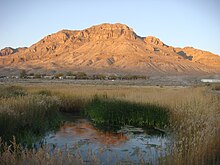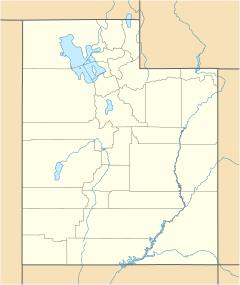Great Salt Lake Desert
| Great Salt Lake Desert | |
|---|---|
 The desert's white salt is depicted in Utah's northwest. | |
| Area | 4,000 sq mi (10,000 km2) |
| Geography | |
| Country | United States |
| State | Utah |
| County | |
| Borders on | Cedar Mountains, Silver Island, Hogup, Newfoundland Mountains, & Lakeside Range West (NV): Pilot Range. |
| Coordinates | 40°42′N 113°36′W / 40.7°N 113.6°W |
The Great Salt Lake Desert (colloquially referred to as the West Desert) is a large dry lake in northern Utah, United States, between the Great Salt Lake and the Nevada border. It is a subregion of the larger Great Basin Desert, and noted for white evaporite Lake Bonneville salt deposits including the Bonneville Salt Flats.[1]
Description
[edit]
Several small mountain ranges occupy the edges of the desert, such as the Cedar Mountains, Lakeside Mountains, Silver Island Mountains, Hogup Mountains, Grassy Mountains, and Newfoundland Mountains. On the western edge of the desert, just across the border in Nevada, stands Pilot Peak in the Pilot Range.
The desert is cool during the winter and includes unusual plants adapted to the dry conditions. Most of the desert receives less than 8 inches (200 mm) of annual precipitation.[2] The salt crust covering the desert reforms yearly when the rain evaporates. The military's Utah Test and Training Range is in the northern portion of the desert. The lowest part of Juab County is located just south of the Dugway Proving Grounds, about 1.5 miles (2.4 km) northwest of the northwest corner of the Fish Springs Range.[3]
History
[edit]
During Jedediah Smith's 1826-27 expedition, Robert Evans nearly died while crossing the desert [4] and in the 1840s, westward emigrants used the Hastings Cutoff through 130 miles (210 km) of Great Salt Lake desert to reduce the distance to California. The 1846 Donner Party's difficulties in making the crossing contributed to their becoming snowbound in the Sierra Nevada. Howard Stansbury explored the desert in 1849.[5] In 1956, I-80 replaced the Wendover Cut-off across the desert, including a straight east-west section for ~50 miles (80 km) between the Cedar Mountains to the east and Wendover on the Utah/Nevada border. Following a railway completed across the desert's Bonneville Salt Flats in 1910, the flats were first used as a speedway in 1914. The world records for highest land speeds are regularly broken here.
Recent discoveries
[edit]In July 2022, archaeologists discovered about 88 footprints had been left behind by humans at least 12,000 years ago using ground-penetrating radar (GPR). In the "ghost tracks", as the archaeologists called them, the footprints absorb moisture and are only visible when it rains and disappear when dry.[6][7]
Climate
[edit]The Great Salt Lake Desert experiences a desert climate with hot summers and cold winters. The desert is an excellent example of a cold desert climate. The desert's elevation, 4,250 feet above sea level, makes temperatures cooler than lower elevation deserts, such as the Mojave. Due to the high elevation and aridity, temperatures drop sharply after sunset. Summer nights are comfortably cool. Winter highs are generally above freezing, and winter nights are bitterly cold, with temperatures often dropping below freezing.
| Climate data for Knolls, Great Salt Lake Desert, Utah. (Elevation 4,250ft) | |||||||||||||
|---|---|---|---|---|---|---|---|---|---|---|---|---|---|
| Month | Jan | Feb | Mar | Apr | May | Jun | Jul | Aug | Sep | Oct | Nov | Dec | Year |
| Record high °F (°C) | 63 (17) |
63 (17) |
79 (26) |
87 (31) |
98 (37) |
104 (40) |
106 (41) |
103 (39) |
99 (37) |
89 (32) |
71 (22) |
66 (19) |
106 (41) |
| Mean daily maximum °F (°C) | 36.5 (2.5) |
41.4 (5.2) |
54.4 (12.4) |
62.3 (16.8) |
72.3 (22.4) |
83.5 (28.6) |
92.8 (33.8) |
90.9 (32.7) |
80.0 (26.7) |
64.3 (17.9) |
46.5 (8.1) |
36.5 (2.5) |
63.4 (17.4) |
| Mean daily minimum °F (°C) | 16.9 (−8.4) |
19.3 (−7.1) |
29.1 (−1.6) |
36.6 (2.6) |
44.9 (7.2) |
54.7 (12.6) |
62.1 (16.7) |
59.5 (15.3) |
48.0 (8.9) |
34.4 (1.3) |
23.3 (−4.8) |
14.5 (−9.7) |
37.0 (2.8) |
| Record low °F (°C) | −16 (−27) |
−17 (−27) |
−1 (−18) |
14 (−10) |
24 (−4) |
35 (2) |
43 (6) |
39 (4) |
25 (−4) |
8 (−13) |
−3 (−19) |
−25 (−32) |
−25 (−32) |
| Average precipitation inches (mm) | 0.61 (15) |
0.46 (12) |
0.91 (23) |
1.01 (26) |
1.23 (31) |
0.68 (17) |
0.36 (9.1) |
0.31 (7.9) |
0.56 (14) |
0.77 (20) |
0.61 (15) |
0.38 (9.7) |
7.88 (200) |
| Average snowfall inches (cm) | 0.3 (0.76) |
0.1 (0.25) |
0 (0) |
0 (0) |
0 (0) |
0 (0) |
0 (0) |
0 (0) |
0 (0) |
0 (0) |
0 (0) |
0.1 (0.25) |
0.5 (1.3) |
| Source: The Western Regional Climate Center[2] | |||||||||||||

References
[edit]- ^ U.S. Geological Survey Geographic Names Information System: Great Salt Lake Desert
- ^ a b "Seasonal Temperature and Precipitation Information". wrcc.dri.edu. Western Regional Climate Center. Retrieved 24 Mar 2013.
- ^ Nash, Fred J (2008). Utah's Low Points: A guide to the Lowest Points in Utah's 29 Counties. University of Utah Press. pp. 114–122. ISBN 978-0-87480-932-9.
- ^ Smith, Jedediah Strong. "Diary of Jedediah Strong Smith: The Crossing of the Great Salt Lake Desert". xmission.com. Retrieved 26 Dec 2016.
- ^ Tea, Roy D. "The Great Salt Lake Desert". scienceviews.com. Retrieved 26 Dec 2016.
- ^ Harry Baker (2022-08-02). "'Ghost footprints' left by ancient hunter-gatherers discovered in Utah desert". livescience.com. Retrieved 2022-08-15.
- ^ "An ancient footprint ghost track that appears only after it rains is discovered". GIGAZINE. 4 August 2022. Retrieved 2022-08-15.
External links
[edit] Media related to Great Salt Lake Desert at Wikimedia Commons
Media related to Great Salt Lake Desert at Wikimedia Commons

